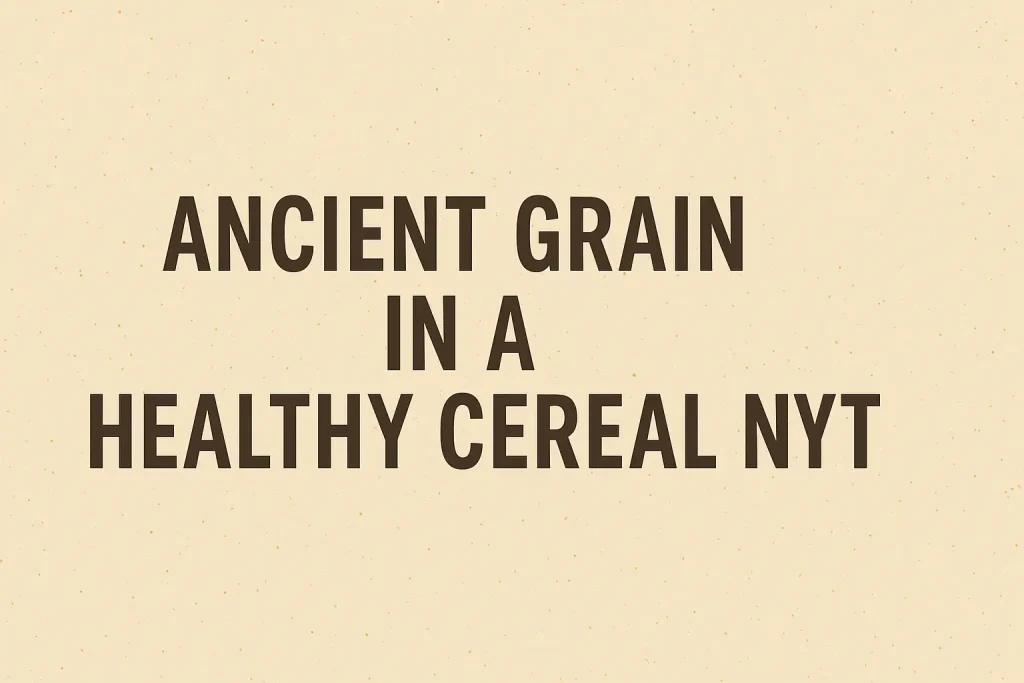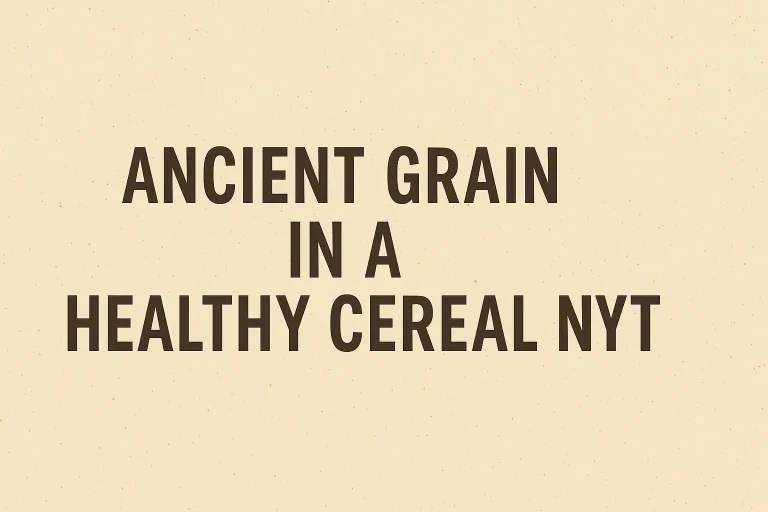
Ancient grains are making a powerful comeback, and not just in the kitchen—they’ve even found their way into the New York Times (NYT) crossword! If you’ve seen the clue “ancient grain in a healthy cereal NYT,” you’re part of a growing trend that celebrates nutritious, heritage grains like spelt, quinoa, and farro. This article dives deep into that clue while delivering expert knowledge about these superfoods that are changing breakfast tables worldwide.
What is Ancient Grain in a Healthy Cereal NYT?
The answer to the famous NYT crossword clue is spelt—an ancient grain known for its rich nutrients and hearty flavor. Beyond its crossword fame, spelt has earned its place in healthy cereals and diets around the globe. In fact, ancient grains like spelt are treasured by the Whole Grains Council and food giants like General Mills for their impressive health benefits.
Spelt: The Answer and the Superfood Grain You Need to Know
Spelt is one of the oldest cultivated grains, dating back over 5,000 years. This nutritious, fiber-rich cereal has a sweet, nutty flavor that makes it a favorite among health-conscious eaters. Often found in whole grain cereal blends, spelt is not only a crossword solution but also a superfood staple in modern kitchens. Spelt grain boasts high protein, fiber, and essential minerals like magnesium and iron. Thanks to its low glycemic index, spelt is an excellent choice for sustained energy. Whether in bread, pasta, or breakfast cereals, this ancient grain deserves the spotlight.
Also Read: https://gossipsmag.co.uk/aaron-kendrick-de-niro/
Complete List of Ancient Grains Used in Healthy Cereals
Ancient grains go beyond spelt, enriching our diets with variety and nutrition. Here’s the complete lineup making waves in healthy cereals:
- Einkorn
- Farro
- Quinoa
- Amaranth
- Kamut
- Millet
- Teff
- Sorghum Each of these grains is celebrated for being fiber-rich and packed with antioxidants, making your morning bowl a heart-healthy powerhouse.
Why Ancient Grains Like Spelt Are Trending in Modern Diets
- They’re naturally rich in nutrients, including protein, fiber, and minerals.
- They are often less processed than modern grains, retaining more health benefits. Ancient grains have become synonymous with clean eating and wellness. As consumers shift away from refined grains, these heritage grains offer a satisfying, nutritious alternative that aligns perfectly with today’s health trends.
Nutritional Benefits of Spelt and Other Heritage Grains
- High in dietary fiber for improved digestion and heart health.
- Packed with vitamins like B3 (niacin), and minerals such as iron, magnesium, and zinc. Spelt and its grainy cousins are not only tasty but also powerful allies in maintaining a balanced diet. Their complex carbohydrates provide sustained energy, while their high nutrient density supports overall wellness.
Popular Crossword Clues Featuring Ancient Grains
Ancient grains are no strangers to crossword enthusiasts. Clues often reference these nutritious grains:
- “Ancient grain in cereals” (Answer: spelt)
- “Protein-rich ancient seed” (Answer: quinoa)
- “Mediterranean grain” (Answer: farro) These clues keep ancient grains relevant, educating puzzlers while entertaining them.
Top Healthy Cereals That Include Ancient Grains
- Kashi GO Original – Features quinoa and amaranth.
- Bob’s Red Mill Muesli – Packed with spelt, kamut, and oats.
- Nature’s Path Qi’a Superfood Cereal – Loaded with chia, buckwheat, and quinoa. These cereals combine ancient grains with modern flavors, delivering both taste and nutrition in every bite.
Difference Between Ancient Grains and Modern Grains
Ancient grains are largely unchanged over thousands of years, preserving their original nutrient profiles. In contrast, modern grains like wheat have been selectively bred, sometimes at the cost of nutrition and digestibility. While modern grains dominate grocery shelves, ancient grains offer a return to wholesome, minimally processed food that nourishes the body and soul.
Is Spelt Gluten-Free? Everything You Should Know
Spelt does contain gluten, though some people with mild sensitivities find it easier to digest than modern wheat. However, it is not suitable for those with celiac disease. For gluten-free alternatives, grains like quinoa, amaranth, and millet make excellent choices without compromising on nutrition.
How Ancient Grains Support Heart and Digestive Health
- Their high fiber content helps lower LDL (bad) cholesterol and regulate blood pressure.
- The presence of prebiotics promotes healthy gut bacteria, improving digestion. Regular consumption of ancient grains can reduce the risk of heart disease, type 2 diabetes, and digestive issues, making them essential for long-term health.
Crossword Lovers’ Guide to Grain-Related Puzzle Clues
Grains like spelt, quinoa, and farro are crossword gold. They’re short, vowel-heavy words that fit perfectly into tricky grids. Crossword fans should familiarize themselves with these terms—they pop up more often than you’d think! The NYT Crossword has helped popularize these grains, turning obscure food items into common knowledge among its massive readership.
Best Ways to Add Ancient Grains to Your Daily Diet
Ancient grains are versatile and easy to include in meals. Cook up quinoa as a side dish, sprinkle amaranth into smoothies, or enjoy a warm bowl of farro salad. Breakfast cereals remain a top choice—mix spelt flakes with fresh fruits and nuts for a morning meal that’s both satisfying and heart-healthy.
The Rise of Ancient Grains in Breakfast Cereals
Once niche, ancient grains now headline many breakfast products thanks to brands like General Mills and endorsements from the Whole Grains Council. Their surge in popularity is driven by health-conscious consumers seeking natural, nutrient-dense options without artificial additives.
Are Ancient Grains Really Healthier? Science Says Yes
Scientific studies consistently highlight the health advantages of ancient grains. Their antioxidant content, higher fiber levels, and better mineral profiles make them a superior choice. Research published by nutrition experts supports their role in reducing inflammation and improving metabolic health—facts that boost their credibility among dietitians.
Spelt vs. Quinoa vs. Farro: Comparing Ancient Grains
Spelt offers more protein and a nutty taste, making it ideal for baking and cereals. Quinoa, a gluten-free seed, excels in protein and amino acids. Farro, another heritage grain, stands out with its chewy texture and subtle sweetness. Choosing among them depends on dietary needs: spelt for fiber, quinoa for protein, and farro for texture.
How the NYT Crossword Keeps Ancient Grains Popular
- Frequent clues featuring grains spark curiosity and drive Google searches.
- Crossword solvers often discover ancient grains through puzzle-solving. Thanks to the NYT Crossword, grains like spelt and quinoa stay culturally relevant, bridging the gap between nutrition and popular entertainment.
Ancient Grains and Their Cultural History Across Civilizations
Ancient grains have nourished civilizations from Mesopotamia to the Andes. Spelt sustained the Romans, quinoa was revered by the Incas, and farro fed the Egyptians. Their resilience and adaptability have made them timeless staples, with a rich legacy that continues to thrive in modern diets.
Shopping Guide: Where to Buy Authentic Ancient Grains
You can find high-quality ancient grains at health stores, supermarkets, and online retailers like Amazon. Look for brands certified by the Whole Grains Council to ensure authenticity. Farmers’ markets are also great spots to buy locally sourced grains, supporting small producers while enjoying fresh, nutritious options.
Debunking Myths About Spelt and Other Ancient Grains
Myth: Spelt is gluten-free. Fact: It contains gluten and isn’t safe for celiacs. Myth: Ancient grains are hard to cook. Fact: They’re just as easy as modern grains and even more versatile in recipes.
Recipes Using Spelt and Other Ancient Grains for Breakfast
- Spelt Pancakes with honey and berries.
- Quinoa Porridge with almond milk and cinnamon.
- Farro Breakfast Bowls with roasted nuts and dried fruits. These recipes are not only delicious but also fuel your day with sustained energy and essential nutrients.
FAQs
Q: Is spelt the only ancient grain used in NYT crosswords?
A: No, other grains like quinoa and farro have also appeared as clues.
Q: Are ancient grains better for weight loss?
A: Their high fiber content helps you feel full longer, which can aid in weight management.
Q: Can I eat ancient grains if I’m gluten intolerant?
A: Stick to gluten-free grains like quinoa, amaranth, and millet.
Final Thoughts
Ancient grains like spelt are more than crossword answers—they’re nutritional powerhouses that reconnect us with our heritage and boost our health. Whether you’re solving puzzles or upgrading your breakfast, these grains offer unbeatable benefits. Embrace them, enjoy their flavors, and make every meal a celebration of wholesome goodness.




